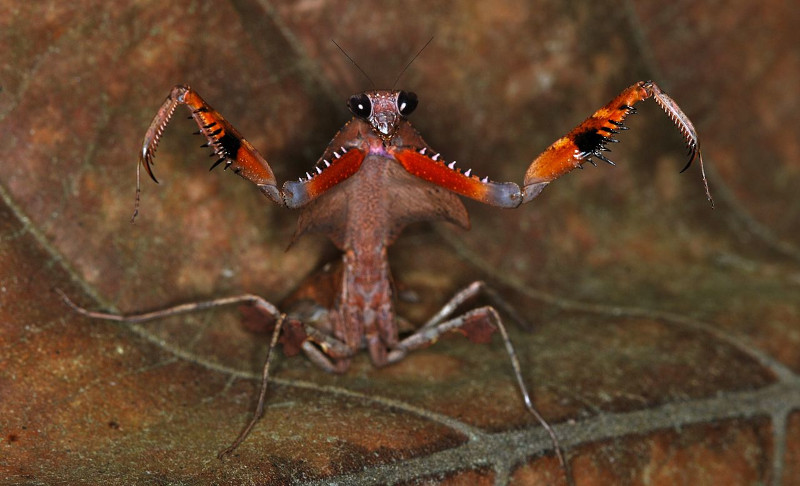Malaysian Dead Leaf Mantis Facts
- The most frequently used common name for this marvel of Nature and evolution is the descriptive term of the Malaysian Dead Leaf Mantis. This remarkable insect’s also, however, sometimes referred to by the somewhat misleading term of the giant dead leaf mantis.
- Professional researchers, though, typically refer to the marvel by its formal scientific name. That term, however, like many such technical names, remains somewhat hard to pronounce. That’s because professionals refer to the insect by the term Deroplatys desiccata.
- Regardless of what one chooses to call this natural wonder, it’s a fascinating and truly captivating creature. The alternate common name, though, is slightly misleading. That, however, isn’t at all unusual, as common names often give a false impression of the species.
- Though larger than some of its many kindred, it’s by no means a giant among its roughly 1,800 known related species, overall. Yet, it nevertheless does qualify as a giant, in a way, though. That’s because it attains a somewhat larger size than any other leaf mantis, specifically.
- The highly respected English entomologist, as well as archaeologist, John Obadiah Westwood, made the first recorded recognition of it as a separate and distinct species. That notable individual achieved this scientifically noteworthy achievement accomplished in the year 1839.
- Fortunately, its population base appears to be both sizeable and relatively stable. This pleasant situation further appears to hold true throughout the entirety of its known native range. Unfortunately, it’s also become quite popular among those who keep insects in captivity.
- Due to these facts, the IUCN presently has no listing for the Malaysian Dead Leaf Mantis on its Red List of Threatened Species. In the wild, it nevertheless faces several potential threats. Habitat loss poses an potential danger to it, along with the effects of climate change.
Related Articles
Malaysian Dead Leaf Mantis Physical Description
Like virtually all of its many relatives across the globe, the magnificent Malaysian Dead Leaf Mantis ranks as a literal master of camouflage. In its specific case, its own name gives an indication of its approach. That’s due to the fact that, when it wishes, it closely resembles a dead, dry leaf.
Like many insects of all kinds, this product of evolution also displays the physiological trait of sexual dimorphism. In its case, this trait merely manifests itself in terms of sheer physical size. The overall size difference between the two genders, however, remains comparatively minor.
More precisely, the females, again, like many of its innumerable relatives, attains a greater mean length than the male of the species. Mature females reach an average length of 3 – 3.1 in (7.5 – 8 cm). Males, meanwhile, grow to a body length that usually measures roughly 2.6 – 2.8 in (6.5 – 7 cm).
Otherwise, the two sexes display virtually identical patterns of coloring, with only extremely slight variations ocurring among individuals. Those patterns, though, include a very respectable range of colors. These run from nearly black, to various shades of brown, to an orange-brown hue.
The highly extended thorax of the Malaysian Dead Leaf Mantis possesses an extremely flattened shape. It also manifests intricate patterns, like the veins on a leaf, on the upper surface of its wings. The underside, however, has a mainly black background, with a large eye-like spot on each wing.
- Kingdom: Animalia
- Phylum: Arthropoda
- Class: Insecta
- Order: Mantodea
- Family: Deroplatyidae
- Genus: Deroplatys
- Species: D. dessicata
Malaysian Dead Leaf Mantis Distribution, Habitat, and Ecology
The mesmerizing Malysian Dead Leaf Mantis inhabits a moderately expansive part of the surface of the world. This range consists of the region generally known as southeast Asia. More specifically, it’s known to live in the nations of Sumatra, the Philippines, Borneo, Indonesia, and Malaysia.
Within that greater range, though, it fortunately seems to be moderately adapable in terms of its habitat requirements. That’s due to the fact that observed specimens appear in regions consisting of both tropical forest and scrubland. For now, no evidence that it ever lived elsewhere exists.
This amazing Arthropod’s also supremely adapted for the environment in which it lives. Its coloring, as well as its body shape and design, all serve well to provide it with excellent natural camouflage. The insect even appears to sway in the breeze, mimicking the movements of a dried up leaf.
This learned behavioral pattern serves the amazing creature perfectly within its typical habitat range. That’s because it offers it a certain measure of protection from its own predators. Those hunters include the usual species, such as tree climbing lizards, snakes, and birds, among others.
Like its numerous relatives, the Malaysian Dead Leaf Mantis evolved as a purely carnivorous species. Also like them, it’s a master hunter, preferring to hunt as an ambush predator. The insect also feeds quite opportunistically, consuming virtually any prey of sufficient size, especially moths.
Species Sharing Its Range
Check out our other articles on 6 Captivating European Caves, Black-and-white hawk-eagle, Macquarie Island, Dwarf Crested Iris, California red-sided garter snake, Reef Manta Ray, Striped Possum

